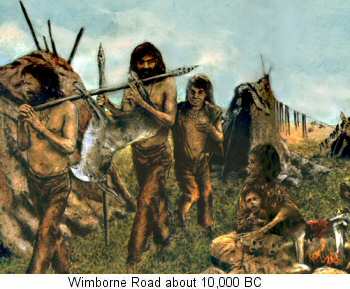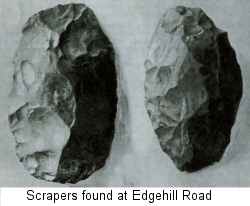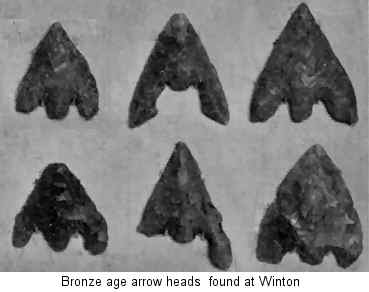|
Ancient Winton
 Winton
may be an Edwardian and Victorian creation, but there has been
life around here for hundreds of thousands of years. Winton
may be an Edwardian and Victorian creation, but there has been
life around here for hundreds of thousands of years.
Archaeological evidence points to people living
in the Winton area in the Stone Age around twelve thousand years
ago.
They were probably wandering hunters who set up
camp for the night wherever they happened to be. Their prey would
have included deer, bison and possibly mammoths.
The proof lies in the flint tools that have been
found around the area. These include flint arrow and spear heads
and scrapers used to remove meat and clean the hides of animals.
Examples have turned up in gardens and waste land
in Winton, Moordown, Charminster Road, Redhill and Kinson.
 These
early Wintonians would have also eaten berries, nuts and various
types of plant. It is believed that it was around this time that
they abandoned grunts and gestures and started to be able to talk
to oneanother. These
early Wintonians would have also eaten berries, nuts and various
types of plant. It is believed that it was around this time that
they abandoned grunts and gestures and started to be able to talk
to oneanother.
The climate was significantly colder than now, but
fortunately the locals had worked out how to create fire.
Winton was a busy farming area during the Bronze
Age (2000 - 700 BC). The inhabitants appear to have come from
across the Channel from the continent.
Their cemeteries have been found across the area
as have numerous bronze arrowheads and tools. Victorian maps show
tumuli and burial mounds dotted all over the area that is now
Winton.
 Just
over a hundred years ago a bronze axe head was found in the middle
of the road near Fiveways. It turned out to be an extremely rare
type normally found in Spain, and proved that Winton may have
been an early tourist destination - even if the tourists were
not always welcome! Just
over a hundred years ago a bronze axe head was found in the middle
of the road near Fiveways. It turned out to be an extremely rare
type normally found in Spain, and proved that Winton may have
been an early tourist destination - even if the tourists were
not always welcome!
Archaeologists have found traces of Iron Age habitation
at various places around Winton - notably at Strouden Park, Ensbury
Park, Redhill and Kinson. The 1880
map of Winton shows burial mounds (tumuli) in several locations
that have since been built over.
Excavations in 1929 at Strouden Farm (which subsequently
became the site of Summerbee School) revealed an Iron Age settlement
and pottery from both the Iron Age and Roman period.
Six years later workmen at Ensbury Park found Iron
Age pottery, clay loom weights, and burnt daub from hut walls
carrying the marks of wattle and ancient finger prints.

|